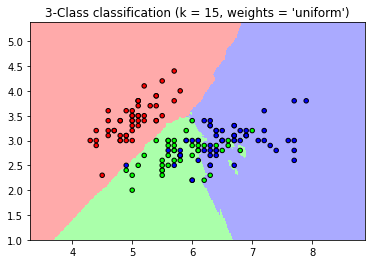Nearest Neighbors Classification
Nearest Neighbors Classification#
Nearest Neighbors 방법은 내부적으로 모델을 생성하지 않고 훈련 데이터를 저장하고 그 유사도를 측정하여 문제를 해결하는 방법입니다. 데이터의 독립변수가 거리기반으로 종속변수와 관계가 있는 데이터일 경우 사용할 수 있습니다.
Nearest Neighbors 는 Neighbor를 선정하는 방식에 따라 K Nearest Neighbors, Radius Neighbors으로 나뉘어 집니다.
K Nearest Neighbors: 사용자가 정의한 K 파라미터 수 만큼의 Nearest Neighbors 데이터를 이용합니다.
Radius Neighbors: 사용가자 정의한 R 파라미터 만큼의 반경안에 존재하는 Neighbors 데이터를 이용합니다.
데이터의 분포가 Sparse 할 경우 KNN 방식은 최근접 K 개의 후보를 선정하는 것에 문제가 있기 때문에 Radius Neighbors 방식을 이용하는 것이 좋습니다.
기본적으로 Neighbors 의 경우 결과 값을 계산할 경우 후보 Neighbors 데이터 결과 값의 uniform 한 가중치를 적용하여 결과 값을 계산합니다. 데이터의 거리 기반으로 결과 값 계산에 다른 가중치를 주고 싶다면, weights 파라미터의 값을 ‘distance’ 로 변경할 수 있습니다.
Weight 기본적으로 Neighbors 의 경우 결과 값을 계산할 경우 후보 Neighbors 데이터 결과 값의 uniform 한 가중치를 적용하여 결과 값을 계산합니다. 데이터의 거리 기반으로 결과 값 계산에 다른 가중치를 주고 싶다면, weights 파라미터의 값을 ‘distance’ 로 변경할 수 있습니다.
Algorithm Neighbor를 찾기 위해 거리를 계산하는 방식을 선택 할수 있습니다. ‘brute’, ‘kd_tree’, ‘ball_tree’ 세가지 방법을 제공합니다. 계산 속도는 데이터 수와 차원에 의해서 결정되기 때문에 기본 값인 ‘auto’ 로 설정되어 있으면, 이 조건에 따라 알맞은 계산 알고리즘이 선택됩니다.
# 경고 메시지 출력 끄기
import warnings
warnings.filterwarnings(action='ignore')
%matplotlib inline
import matplotlib.pyplot as plt
import IPython
import platform, sys
rseed = 22
import random
random.seed(rseed)
import numpy as np
np.random.seed(rseed)
np.set_printoptions(precision=3)
np.set_printoptions(formatter={'float_kind': "{:.3f}".format})
import pandas as pd
pd.set_option('display.max_rows', None)
pd.set_option('display.max_columns', None)
pd.set_option('display.max_colwidth', None)
pd.options.display.float_format = '{:,.5f}'.format
import sklearn
print(f"python ver={sys.version}")
print(f"python platform={platform.architecture()}")
print(f"pandas ver={pd.__version__}")
print(f"numpy ver={np.__version__}")
print(f"sklearn ver={sklearn.__version__}")
python ver=3.8.9 (default, Jun 12 2021, 23:47:44)
[Clang 12.0.5 (clang-1205.0.22.9)]
python platform=('64bit', '')
pandas ver=1.2.4
numpy ver=1.19.5
sklearn ver=0.24.2
# 참조: https://scikit-learn.org/stable/auto_examples/neighbors/plot_classification.html
%matplotlib inline
import numpy as np
import matplotlib.pyplot as plt
from matplotlib.colors import ListedColormap
from sklearn import neighbors, datasets
n_neighbors = 15
# import some data to play with
iris = datasets.load_iris()
# we only take the first two features. We could avoid this ugly
# slicing by using a two-dim dataset
X = iris.data[:, :2]
y = iris.target
h = .02 # step size in the mesh
# Create color maps
cmap_light = ListedColormap(['#FFAAAA', '#AAFFAA', '#AAAAFF'])
cmap_bold = ListedColormap(['#FF0000', '#00FF00', '#0000FF'])
for weights in ['uniform', 'distance']:
# we create an instance of Neighbours Classifier and fit the data.
clf = neighbors.KNeighborsClassifier(n_neighbors, weights=weights)
clf.fit(X, y)
# Plot the decision boundary. For that, we will assign a color to each
# point in the mesh [x_min, x_max]x[y_min, y_max].
x_min, x_max = X[:, 0].min() - 1, X[:, 0].max() + 1
y_min, y_max = X[:, 1].min() - 1, X[:, 1].max() + 1
xx, yy = np.meshgrid(np.arange(x_min, x_max, h),
np.arange(y_min, y_max, h))
Z = clf.predict(np.c_[xx.ravel(), yy.ravel()])
# Put the result into a color plot
Z = Z.reshape(xx.shape)
plt.figure()
plt.pcolormesh(xx, yy, Z, cmap=cmap_light)
# Plot also the training points
plt.scatter(X[:, 0], X[:, 1], c=y, cmap=cmap_bold,
edgecolor='k', s=20)
plt.xlim(xx.min(), xx.max())
plt.ylim(yy.min(), yy.max())
plt.title("3-Class classification (k = %i, weights = '%s')"
% (n_neighbors, weights))
plt.show()


from sklearn import datasets, model_selection, neighbors, metrics
# 데이터
n_samples = 10000
xs, ys = datasets.make_classification(
n_samples=n_samples, # 데이터 수
n_features=10, # X feature 수
n_informative=3,
n_classes=3, # Y class 수
random_state=rseed) # 난수 발생용 Seed 값
print(f"data shape: xs={xs.shape}, ys={ys.shape}")
train_xs, test_xs, train_ys, test_ys = model_selection.train_test_split(
xs, ys, test_size=0.3, shuffle=True, random_state=rseed)
print(f"train shape: train_xs={train_xs.shape}, train_ys={train_ys.shape}")
print(f"test shape: test_xs={test_xs.shape}, test_ys={test_ys.shape}")
# 모델
models = [
neighbors.KNeighborsClassifier(5),
neighbors.KNeighborsClassifier(5, weights='distance'),
neighbors.RadiusNeighborsClassifier(3.9),
neighbors.RadiusNeighborsClassifier(3.9, weights='distance')
]
for model in models:
# 학습
print(f"\nmodel={model}")
model.fit(train_xs, train_ys)
# 평가
pred_ys = model.predict(test_xs)
acc = metrics.accuracy_score(test_ys, pred_ys)
print(f"acc={acc:.5f}")
cr = metrics.classification_report(test_ys, pred_ys)
print(f"classification_report\n{cr}")
data shape: xs=(10000, 10), ys=(10000,)
train shape: train_xs=(7000, 10), train_ys=(7000,)
test shape: test_xs=(3000, 10), test_ys=(3000,)
model=KNeighborsClassifier()
acc=0.84033
classification_report
precision recall f1-score support
0 0.86 0.89 0.88 968
1 0.77 0.84 0.80 981
2 0.91 0.79 0.85 1051
accuracy 0.84 3000
macro avg 0.84 0.84 0.84 3000
weighted avg 0.85 0.84 0.84 3000
model=KNeighborsClassifier(weights='distance')
acc=0.84233
classification_report
precision recall f1-score support
0 0.87 0.89 0.88 968
1 0.77 0.84 0.80 981
2 0.89 0.80 0.84 1051
accuracy 0.84 3000
macro avg 0.85 0.84 0.84 3000
weighted avg 0.85 0.84 0.84 3000
model=RadiusNeighborsClassifier(radius=3.9)
acc=0.81333
classification_report
precision recall f1-score support
0 0.80 0.85 0.82 968
1 0.74 0.81 0.77 981
2 0.92 0.79 0.85 1051
accuracy 0.81 3000
macro avg 0.82 0.81 0.81 3000
weighted avg 0.82 0.81 0.81 3000
model=RadiusNeighborsClassifier(radius=3.9, weights='distance')
acc=0.82533
classification_report
precision recall f1-score support
0 0.83 0.86 0.84 968
1 0.75 0.83 0.79 981
2 0.92 0.79 0.85 1051
accuracy 0.83 3000
macro avg 0.83 0.83 0.83 3000
weighted avg 0.83 0.83 0.83 3000

